The Fernald Reading Method
This landmark article co-authored by the legendary Helen Keller provides the the first detailed description of the 'Fernald Technique'; Grace Fernald's revolutionary multisensory reading method, which she developed to help children who had failed to learn to read.
The Article in Full
The cases reported in this paper are all those of children of normal mentality who have failed to learn to read after three or more years in the public schools. In all cases but one the vision was normal. The method described here was used only after the child had been given several weeks of individual instruction by recognized methods and had failed to make any improvement.
Many children who have been brought to us as non-readers with individual instruction and proper motivation, learned to read quite easily by ordinary methods when they were given individual instruction and proper motivation; others proved to be mentally deficient. In five years we have found only seven cases of actual non-readers, even though children have been brought to us from all parts of the state. In all seven cases the presumption of mental deficiency had been made as the explanation of the reading failure. In all but one case, however, the intelligence quotient was found to be at least 100 by the Stanford Revision.
METHOD
1. Learning first words. - The child was asked to tell some word he would like to learn. The word was written in large script on the blackboard or with crayola on cardboard. The child looked at the word, saying it over to himself and tracing it if he wished to do so. The tracing was done with the first two fingers of the right hand (or of the left hand if the child was left-handed) resting on the copy. It was never done in the air or with pencil. When the child was sure he knew the word, the copy was erased and he attempted to write the word, saying the syllables to himself as he wrote them. If he was unable to write the word correctly, the entire process was repeated until the word could be written without the copy. At no stage of the performance was he allowed to copy the word. After a few words had been learned in this way, he was shown the word in print as well as in script. The next day he was shown the word in print only. If he failed to recognize it, it was written for him. If he still failed to recognize it, it was retaught as on the first presentation.
2. Spontaneous sentences. - After the first few days the child began to ask for sentences instead of words. A sentence was then written and he learned the words comprising it, finally writing the entire sentence as many times as he wished - always from memory, never from copy. The sentences the child had requested were then printed on cardboard or were typewritten. These sentences and others, made of the same words, were read by the child. The same words were repeated in different sentences from day to day.
3. Words in context or story selected by the child. - As soon as the child was able to make out simple sentences, he was taken to the library and allowed to select a book. The first paragraphs read were worked over in the following manner. Before the reading, each word which had not already been learned was exposed. through an adjustable slit in a piece of cardboard. If the child failed to read the word it was pronounced for him. He pronounced and then wrote the word (as before without looking at the copy). If he had difficulty in writing the word after seeing it in print, it was written for him and taught from the script as in the case of the first words.
4. Apperception of phrases. - After the words in the new paragraph had been taken up in this manner, brief exposures of the words were given until the child was sure of them. When recognition was immediate for every word, the slit was adjusted to phrases, and flash exposures of the various phrases were given. The exposures were never long enough to permit the phrases to be read word by word. As many successive exposures as were necessary for recognition were given. After the entire paragraph had been worked over in this way, the child was told to read the paragraph to himself and report what he had read.
5. Silent reading for content. - As soon as possible the child was encouraged to read to himself. There was no difficulty in any of our cases in getting him to do this after his progress had gone into the fourth phase as described above.
|
Seven cases have been successfully treated to date. Four of these are described in the following pages. In one case, included under the above statement, the work is incomplete at the present time, but the results showed normal progress during the period of experimentation. Two additional cases, one from New York, and one from Colorado, now under investigation, have both reached the third stage. In the latter of these two cases the child is now able to learn new words rapidly from print and to write them correctly although he was unable to read or write his own name two months ago. |
|
CASE 1. BOY (LESTER)
Age (December, 1916) 10-2; mental age (Binet-Simon, 1911 Scale), 9-0. Re-tested December, 1920; age, 14-2; mental age (Stanford Revision), 13-4; I. Q., 94. Vision, normal.
School history. - Lester had been in the public schools of Los Angeles for five years (including one year in the kindergarten). When brought to our notice he had been in the second grade of the Normal Training School for two months, having been entered in the Training School as a last resort after his failure in the city schools. On account of his size, he was first placed in the second grade; but, as he was unable to distinguish one-syllable sight words, he was put back into the first grade. Here a special effort was made to teach him to read in a small group where special instruction was possible. Since he made no progress whatever, he was reported to the psychology department as mentally deficient.
As the results of the mental test did not show sufficient retardation to account for his complete inability to read, we kept the boy under observation for some time. The case came to our notice at a time when we were particularly engaged with poor spellers. Accordingly, we put Lester into a group of our worst spellers, where individual work was being done.
Method. - The work in the spelling class referred to was being conducted in the following manner: The children watched while the word was written on the blackboard or on cardboard. They said the word over to themselves, tracing it with their fingers if they wished to do so. The tracing was done with the first two fingers of the right (or left) hand in contact with the copy. Tracing in the air or with pencil did not seem to produce the same results as tracing with the fingers. When each child was sure of the word, it was erased or otherwise removed from view, and the child wrote the word, saying the syllables to himself as he wrote them. He was allowed to write the word as many times as he wished, provided he did not copy it from a previous writing. Except for this special work in spelling, the method was the same as that described on page 355.
Results. - Lester developed a craze for writing words. He would work at it by the hour, tracing words over and over again. To our surprise, after the first week, he seemed to be able to write from memory words which he had written previously several days in succession.
We had the same words which he had learned to write printed; and each time the boy wrote a word in script we showed him the corresponding printed form. Recognition was developed almost immediately for the words he had written. At first he learned only two or three words a week, then several a day. After about two months, he was able to look at a word in print, say it over to himself, and write it correctly. This was true even of words of three and four syllables. At this stage of his development, after he had once written a word, he would almost invariably recognize it on successive presentations. Yet, on the other hand, if told a word over and over again on successive days, he failed to recognize it unless he wrote it.
Since the boy was interested in history, and especially in the war, we chose a history of the United States as our first book. The method employed is described in the introductory statement on method.
Unfortunately we had no idea of the significance of the work and kept no records of the exact words written from day to day, as we did in our later cases: Much of the writing was done on the blackboard and immediately erased.
The boy seemed suddenly to go ahead by jumps. At the end of five months he was reading so readily that we had a demonstration before his various first and second-grade teachers. They refused to believe that he was actually reading until they brought books selected by themselves and tried him out with both oral and silent reading.
After six months in the University Training School, the family moved and the boy went back to the regular city schools.
December 15, 1920, just four years after our first experience with Lester, we found him doing satisfactory work in the seventh grade of the city schools. His teacher was surprised when we asked about his reading, and said he was an inveterate reader.
TABLE 1. RESULTS OF READING TESTS
Note: Lester had never seen any of the upper grade Kansas Silent Reading Tests before the test was given December 1920.
Summary of case. At the age of ten years, after over four years in the elementary grades of the public schools, Lester was totally unable to read.
In six months he developed from a zero score in reading ability to ready word recognition. For the last three and a half years, without further special instruction, his development in both silent and oral reading has been perfectly normal. During this period he has advanced from the first to the seventh grade.
CASE 2. BOY (HENRY)
Age, 9-8; Mental Age (Stanford Revision), 12-8; 1. Q., 131. Vision, normal.
School history. - Henry entered the kindergarten of the University Training School when five years old, and has attended the same school continuously to date, except for part of one year lost on account of measles and whooping cough.
He seemed unable to learn to read or spell although he had been given individual instruction, including drill in phonics. He was referred to the psychology department as a possible mental defective. Although the results of the mental tests indicated unusual ability, he was found to be below second-grade rating in the Kansas Silent Reading Test and in the Ayres Spelling Scale. He also failed completely in all tests for phonics.
Method. - The method was the same as that previously described, except that Henry did not tend to trace the words. He would look at a word which had been written for him, say it over slowly, have the copy removed, and then write it saying each syllable as he wrote it. He soon developed considerable skill in writing words in this way; but he was very slow at first in making the association bet ween the word he had written and the printed word. In the beginning it was necessary to present each word daily for five or six days before the association with the printed word was formed.
There was so little progress for the first few weeks that the psychology department was consulted repeatedly with reference to the seeming failure of the boy to develop word recognition. His mother came often to observe and expressed herself as convinced that it was simply another failure. She felt that she had tried everything. Besides being in a small class with a particularly successful teacher, he had received special help at home and special work in phonics with the reading department. Every effort had been made to encourage the boy; he had ·even been promoted to the fourth grade in order to try the effect of encouragement. As he could do nothing with fourthgrade reading and spelling he went back into the special study room. It was with difficulty that we obtained the mother's consent to have the boy tested mentally. She has since told us that she was afraid he would be found mentally deficient. When informed of the results of the test, she was frankly skeptical. It should be stated, however, that she was very careful not to let the boy know of her discouragement and that she cooperated with us throughout the experiment.
After the fifth week Henry suddenly began to make such rapid progress that it was almost impossible to keep track of him. He could write any word after a single presentation and after he had once written it, he would recognize it in either script or print on subsequent presentation. As one of the student teachers expressed it, he was "on." Five weeks after our first work with him, he wrote the word Switzerland after one presentation and recognized it in print twenty-four hours later.
Henry's first reading was in the second reader. It was necessary to write the new words and to have him write them before he could recognize the word on subsequent presentations. The development of a reading vocabulary was very rapid, however, after the first few weeks, since it was rarely necessary for him to write a word more than once, and since he was able to give one glance at the printed word, say it, and write it. He worked much by himself, asking anyone to pronounce a word, and then writing it off on a slip of paper.
From the time when Henry began working alone it was difficult to keep track of his progress. By May, three and a half months after we began the experiment, he was working out many new words without having them pronounced for him or without needing to write them. Though he had received no instruction in phonics since the experiment began, and had seemed at that time to have no knowledge of them, a test given May seventeenth showed the beginning of the development of the recognition of phonetic units.
Work was begun in February and discontinued in June at the close of the school year. The mother reported that the boy read everything available during the summer - library books, newspapers, advertisements, etc. On his return to school he went into the regular fifth grade. At the date of this writing (March, 1921), he is doing satisfactory work in all his subjects. Formal tests given in November showed his ability to be between that of the fourth and fifth grade according to both the Starch and Kansas tests, and above that of the sixth grade according to the Gray Oral Reading Test.
Formal reading, spelling, and phonics tests. - The following results were obtained from tests of spelling, reading, and phonetics. On January 30, 1920, Henry was given a selection of words from Column 1 of the Ayres Spelling Scale. His rating was ten percent, and the character of this performance may be judged from the fact that the second-grade standard for these words is fifty percent. The following are the word forms as he actually wrote them, the words in parentheses being the correct forms.
On April 25, 1920, another selection of words was given from Column I of the Ayres scale. This time Henry's record was ninety-five percent which compared favorably with the standard for the fifth grade (ninety-four percent).
On February 6, 1920, and again on November 22, 1920, Henry was tested with the Kansas Silent Reading Test, Form I, Test I, with the following results. In the first test his rate score was 36 and his comprehension score was 4. The lowest grade for which standards on the Kansas Silent Reading Test are available is the third grade. For this grade the standard in rate is 52 and in comprehension, 7.2. Thus, Henry's performance was considerably below that which one would expect of a typical third-grade child. On the second application of the test (November, 1920) Henry's rate score was 103 and his comprehension score was 18. This compares favorably with the fifth-grade standard of 89 for rate and 19 for comprehension.
On November 22, 1920, Henry took the Starch reading test for the third, fourth, and fifth grades. His scores in comparison with the standards for each of these grades follow.
Phonics test. - Although every effort has been made to teach Henry phonics in the second and third grades, the results of all phonics tests in January, 1920, were entirely negative. He had no idea of the sound significance of letter combinations.
The following results were obtained in tests given by the reading department. No instruction in phonics had been given since the experiment was started.
Summary of spelling and reading tests. - (a) Spelling: Progress from below second grade to fifth-grade standing in three months. (b) Reading: Progress from much less than third-grade record to fifth-grade in six months. (c) Phonics: Although no instruction had been given in phonics between January and May, and although Henry seemed to have no knowledge of phonics at the earlier date, tests given at the later date showed the development of associations between many letter combinations and their sound values. Tests given in December of the same year showed his knowledge of phonics to be quite equal to that of the average child in the fifth grade.
Summary of case. - A year ago, Henry was not able to do second-grade work in reading and spelling. After four months' instruction, he was put into the fifth grade and has had no difficulty in keeping up to the fifth-grade standards for the five months of this year. He is now in the second half of the fifth grade, and is reported as reading books of every description out of school hours.
CASE 3. BOY (FRED)
Age, 9-2; mental age (Stanford Revision), 9-3; I.Q., 100. Vision. right, normal; left, two-thirds normal.
School history. - Fred attended the public schools of Riverside, California, where he entered the kindergarten at the age of five. He spent three years in the first grade. He entered the University Training School, September. 1920, and was placed in the second grade but made no progress during the first month. He was unable to read words of one syllable, and consequently was too poor to be tested by any formal test. He was sent to the Psychology Department for a mental test with the definite suggestion that he be transferred to one of the public school rooms for the mentally deficient. The child had so much the appearance of a mental defective that we were surprised at the results of the mental tests.
A month after his entrance into the University Training School Fred was given tests in phonics and in spelling. In phonics he wrote such unrelated forms as the following: for on, am; for at, oot; for in, tn; for ish, ih. In spelling he missed all but two of of eight words, writing the following forms for the words given in parentheses:
First phase - learning first words. Fred spent the morning learning to write the four words will, you, am, boy, all of which he had asked for. The words were taught one at a time; each being written by the teacher on the board. Fred said each word over and traced it with his fingers until he was sure he could write it. It was then erased, and he attempted to write it. If the first attempt was not successful, the entire process was repeated until the word was written correctly.
Fred succeeded in writing each of the words correctly in the course of the morning. In the afternoon he attempted to rewrite the same words with the following results: W (for will); Yo (for you); ow (for am); b (for boy). The words were retaught and then written correctly. He then asked for the word "I," and wrote:
I am o boy
He wrote this sentence with his left hand, then with his right. There is little difference in the performance with the two hands, but Fred says he likes the left hand better. He usually writes on paper with his left hand and on the board with his right.
TABLE 2. RECORD OF FIRST WORDS LEARNED BY FRED
October seventh. - He wrote correctly from memory the four words which he had learned the previous day, then asked for door and box. After working for some time on these words, he asked for open, adding "then I'll learn the next and I can write open the door." When the word open was written by the teacher, Fred said, "Erase it quick so I can write it." He next asked for the sentence Open the box till the mouse jumps out. The word mouse had to be presented four times before Fred could write it correctly. By "presented" is meant that the word was written by the teacher and traced by the pupil until the pupil felt sure he could write it.
Table 2 gives the record of the first words learned by Fred and the number of times it was necessary for each to be presented before he was able to write it correctly. Table 2 also shows the results of attempts to write the same words on later dates. The words were all asked for by Fred.
For the next three weeks Fred went through an orgy of writing. He wrote blackboards full of words, then began to write sentences, and finally wrote the letter to his father, as shown in Figure 2.
This letter is only one specimen of the spontaneous compositions with which the boy kept himself occupied by the hour. It was written six weeks after. the attempt to write the words given in Figure 1. He was constantly asking for new words which he learned and wrote from memory. For over a month after writing his first sentence, Fred seemed to care little about subject matter, so absorbed was he in mastering the mechanics of writing. He worked so constantly and so hard that it was necessary to force him to leave the room at recess and at the close of school. He looked up one day after working for two hours at new words and exclaimed, "You know I scarcely ever used to get promoted and now just look at all I am learning." As soon as we attempted to teach him words without having him write them, his interest was lost. He would try to learn them by saying them over and looking at them, but would soon become discouraged and would fail to recognize the words after repeated presentation. This attitude in the early stage of the experiment is particularly interesting, because at the present time (March, 1921) Fred no longer wishes to write unless he has something special to say, but is reading everything he can get hold of. He is as eager over making out new words without writing them as he ever was over the writing process.
Second phase - The association of written with printed words. - Words for which Fred asked were written for him on the typewriter or were shown him in print after he had written them. Simple reading exercises were given, using the words he had written.
Table 3 shows the results with the first words studied for the purpose of reading. The printed word was first shown the boy and then written for him. He studied it on first presentation as he did the words in Table 2, but he was not asked to write a word a second time unless he failed to recognize it on later presentations. Column 3 shows the number of presentations necessary before the word was written correctly.
TABLE 3. RESULTS OF FIRST WORDS PRESENTED FOR READING PURPOSES
Third Phase - Writing the word from memory after looking at the printed copy and having the word pronounced. - Within six weeks after the experiment was started, it was never necessary for Fred to have the word written for him. He was able to look at printed words of several syllables, say them over to himself, and write them correctly from memory. On November seventeenth he wrote disappointed, department, university, and training after seeing the words once in print. A week later he recognized all of these words without any hesitation, and without having seen them in the interval.
Development of projects in connection with reading and writing. November seventeenth. - Fred suddenly decided that he wanted to draw, and was allowed to do so as long as he wished. He drew a picture of a cannon and then of a house and garage with heating system. It was then suggested that he label his pictures, and this idea pleased him greatly. He learned to write the following seven words and used them as labels: cannon, shells, pipe, steps, window, garage, furnace.
November eighteenth. - He wrote correctly without presentation the following words which he had previously learned: you, ride, bicycle, furnace, hide, pipes, rope, because, garage, cannon, want, Riverside, December, October, will, live. He then wrote above the words on the blackboard, "These words are saved."
November nineteenth. - He was taken to the library and allowed to select two books: Lynde's Physics in the Household, and a book on plumbing. From November nineteenth till December sixth, Fred drew and labelled diagrams, finding the words in physics and plumbing books. He was still unable to recognize new words, after he had been told what they were, unless he wrote them. One writing even of very difficult words was usually all that was necessary for word recognition.
November twenty-second. - Fred read the following paragraph without being told any words except those enclosed in parentheses:
The cooler water in the radiator (being heavier) sinks from the radiator into the furnace (boiler) and (forces) the hot water from the (boiler) into the radiator. This hot water gives up its heat to the air in the room and (thus) cools (contracts) and becomes heavier. It then sinks back into the boiler and forces more hot water into the radiator.
This paragraph was read just one and a half months from the time when the boy could not read the simple sentence "I am a boy." He stumbled over a simple word like thus which he had never written, but had no difficulty in reading any of the much harder words which he had written. He was told thus each time he failed to read it, but was quite unable to recognize it on later presentations until he had written it, after which he recognized it whenever it occurred.
December sixth. - Fred suddenly stopped drawing and labelling diagrams and began writing on the blackboard sentences which he would sometimes illustrate with pictures. These sentences and others, containing the same words, were then typewritten and given him to read. For example, the following sentences with a picture of a racing machine at the top of the sheet were written after a visit to the automobile machine shop on December 13, 1920.
A RACER
This is a fine automobile.
It has four wheels on it.
They have tires and mud guards.
It has a steering gear, and a crank on the front.
It has a windshield.
It has a radiator.
It is a Mack and it is a racer.
It runs awfully fast.
Gasoline runs the engine.
The radiator has water in it to cool the engine.
The engine has eight cylinders.
This machine has United States tires.
The engine is a fine one.
The fan helps keep the engine cool.
This machine can tum comers going very fast and it won't wreck.
The following 206 words, written from October sixth to December twenty-second inclusive, are arranged in the order of the frequency with which Fred used them. The numeral after each word indicates the number of times it was used.
On December 22 all the words in this list were shown to him and he recognized all of them except the four marked with an asterisk.
All but four of the words in the above list were asked for by Fred and learned because he wished to read or to write about some particular thing. The four exceptions were "department," "disappointed," "university," and "training" which were given to demonstrate:.the readiness with which he could learn new words.
The numbers after the words indicate the number of separate occasions upon which the word was written in context. The boy often wrote a word over and over again voluntarily, erasing it each time it was written, but as no record was kept of this the actual number of times each word was written is much greater than indicated.
December twenty-second. - Fred began to ask for new words and to remember them without writing them. December twenty-fourth - January fourth. - Christmas vacation.
Fourth phase - Ability to pronounce new words if they resemble words already written. January twenty-fifth. - Fred sounded out the word mother, then said it over several times. He was quite excited over being able to say the word without being told, and began to attempt the same thing with other words.
February fourth. - He worked out, without writing or any help, the following words: surprised, roar, fright, noise, thirsty, dirty, middle. He had to be told dreadful, pronounced towards, to-wards, and vines, vi-nés. He read the fable of the Fox and the Lion to himself and told the story, giving every detail. He had never heard or read the story before.
March third. - Words were given to Fred from the pages of the third reader. The longer words on various pages were given out of context to see whether he could read them without having them pronounced. All the words were new to Fred so far as we know. He read all the words in the following list, mispronouncing only those which are starred. In each case the mispronunciation is indicated.
At the date of writing this paper (March 1921), Fred's progress is so rapid that it is difficult to keep records. He takes library books home, reads to himself, and has to be told only such words as might trouble any child of his age. He has been in the regular third grade for two weeks and is having no difficulty with the work. If his progress continues at the present rate, he should be able to make up the one year necessary to put him in the grade appropriate to his chronological age.
Summary of case. - In October 1920, Fred could not read or write even monosyllabic words. He failed completely in all tests for reading, spelling, and phonics. His school report showed steady attendance with failure of promotion in the city schools of Riverside, California. It was taken for granted that he was mentally deficient until mental tests proved him normal.
At the beginning of the experiment his progress was very slow. He seemed wholly dependent on tracing the words first learned and continued to trace for over two months. His development went through well-marked stages, with the transition from one stage to the next apparently quite sudden.
In March 1921, five months after the experiment was started, he was reading and writing (spelling) well enough to go into the regular third grade. He was taking library books home to read to himself and could read any ordinary story and give its content.
CASE 4. (JOE)
Age (June 1919), 12-5; mental age (Stanford Revision), 15; 1. Q., 120. Vision, normal.
Although incomplete, this case is reported because it differs in certain respects from our other cases. In the first place, in spite of the fact that the boy showed almost no ability in reading or spelling, he did not have to go through the :first two stages described on page 355. From the very start he could write a word from memory, after seeing the printed word, having it pronounced for him, and pronouncing it himself. Thus, he was able to begin with what had proved the third stage in all our other cases. In the second place, the experiment was discontinued before the fourth stage was reached. Joe had learned many new words so that he could read fairly well on certain topics; the work with rapid apperception of phrases had been begun; but the stage had not been reached in which new words were apperceived on the basis of their resemblance to words already learned. The progress of the case during the year and a half of regular school work since the experiment was discontinued is of interest in comparison with the progress made by cases in which the experiment was completed.
School history. - Joe has attended the Los Angeles city schools since he was six years old. From the start he has seemed to be unable to learn to read but has been passed from grade to grade on account of his ability in other subjects, particularly in arithmetic. His grades in the fifth year ranged from B in arithmetic through C - in geography and history to D in English. When questioned as to how he kept up the reading end of some of his school subjects, he explained that he had always managed to work with a boy who could read easily. He helped the other boy with problems in return for help in reading.
Joe was referred to us in June 1919 as a sixth-grade failure. Investigation of the case showed that the entire difficulty was due to an almost complete inability to read. There had been considerable discussion of the case before it came to the psychology department, since two other children in the same family had had the same difficulty with reading.
The case was the more surprising because of the boy's high intelligence quotient and because of his history outside of school. He excelled in games like baseball and was very popular with other boys. The proprietor of a drug store where he worked out of school hours reported that he could keep track of things better than most men.
Since the case came to our attention at the end of the school year, we transferred the boy to a summer school where the experiment could be started. He attended this school intermittently for a month. Since then he has had a few hours of special work, extending over a period of about two weeks. He entered the seventh grade in the fall and is now (a year and a half later, March 1921) in the eighth grade in one of the regular Los Angeles city schools, where he is reported as doing satisfactory work.
Method. - The method was the same as that already described except that, like Henry, Joe never tended to trace words, and was able from the start to learn them directly from the printed copy. Consequently in the case of each word it was only necessary to pronounce it for him, to have him pronounce it to himself as he looked at it, and then to have him write it from memory, saying each syllable as he wrote it.
Results. - Although the results of the first reading and spelling tests were almost entirely negative, Joe possessed from the beginning a remarkable ability to learn new words by the method just described. In spite of the fact that he was unable to recognize short, ordinary words unless they were pronounced for him, he was able to look at a difficult word, pronounce it after someone, and write it correctly from memory, provided he said each syllable to himself as he wrote it. It seemed to make no difference whether he knew the meaning of the word or not. He could write a word like psychophysical after seeing it once and repeating it after some one, and could often rewrite the word, as well as recognize it, after an interval of several days. His ability to write words in this way was so unusual as to attract general attention. It became one form of school entertainment to try to find a word which Joe could not write. To this day he knows certain outlandish words learned in this way. It was, of course, not a part of the plan of instruction to teach any but ordinary words. During the five weeks of summer school he went over the Ayres thousand-word list and developed a considerable reading vocabulary.
A study of Joe as he works shows that he is more dependent than any of our other children on saying the word as he writes it. He makes marked lip movements as he says the syllables to himself and fails completely if he is made to suppress the lip movements.
He usually remembers for an almost indefinite period any word he has ever written, but fails on a subsequent presentation to recognize a word which he has been told repeatedly but which he has not written. At the end of the summer school, when the experiment was discontinued, he had reached the stage where he was beginning to make out a few new words on the basis of their resemblance to words he already knew. For the most part, however, he was still not able to recall words unless he wrote them. Work in rapid apperception of phrases had just been begun.
In the fall of 1919, Joe went into the regular seventh grade and did fairly well in all his studies, except English in which he failed. He seemed to have developed sufficient reading ability to keep up with his work in other subjects.
The experiment was discontinued because his teacher, since he was able to do the work in most of his subjects, considered it unnecessary to take time for the special reading work.
In March 1921, we found Joe in the eighth grade of the regular Los Angeles city schools. He was reported as doing satisfactory work, although slow in subjects requiring reading. Actual tests for reading and spelling give sixth-grade average for spelling and very irregular results for reading. He grades anywhere from the third to the sixth grade by the Kansas Silent Reading Test, below fourth grade by the Starch Silent Reading Test, and makes only half the standard score for the eighth grade by the Gray Oral Reading Test.
The discrepancy in the results of the silent reading tests is easily explained as soon as one observes Joe while be reads. He makes marked lip movements, and stops when he comes to some word he cannot recall, or else mispronounces some word to himself and so loses the sense of the whole. In the latter case he begins again at the beginning and either reads until he gets the meaning or gives up. For example, in the Starch test for the fourth grade, he missed the word waked, read till he came to dawn, went back to the beginning twice, and finally gave it up after getting waked and missing dawn. His score for Test 5 was much better than that for Test 4 because he did not happen to stumble over any particular word.
He is still able to learn a new word almost as rapidly as he can look at it and say itto himself. To determine whether the writing of the word is still essential for word recognition, the following experiment was tried:
He wrote the following words from paragraphs 8, 9, and 10 of the Gray Oral Reading Test: dignifying, station, position, securing, approximately, scrupulously, inclined, contemptuous, silence, complexion. Although he had failed to read any of these words, he wrote each of them correctly after a single presentation consisting only in the exposure of the word while it was pronounced and repeated once. The two words, ingratiatingly and Josephus, were the only ones on which he failed.
The words proportioned, exegencies, profusion, and exhausted were told to him four times and repeated by him each time, but he was not allowed to write them.
He was then asked to read the paragraphs again. He read correctly each of the words he had written but failed on all of the four words which had been pronounced but not written.
The results of educational tests given both at the beginning of the experiment and in March, 1921, indicate the amount of improvement which Joe made during the interval. These tests covered the subjects of spelling and reading. In spelling, words from Column Q of the Ayres scale were given on June 3, 1919. Joe's rating was 10 percent, which may be compared with the standard rating of 58 percent for the fourth grade on words of this column. On June 9, 1919, words from Column Q of the Ayres scale were again dictated. This time, however, the test was given after the words had been learned. Joe's rating was 90 percent. On March 7, 1921, he was tested with words from Columns Q and S of the Ayres scale. On Column Q his rating was 85 percent (standard, 84 for the sixth grade); while on Column S his rating was 80 percent (standard, 73 for the sixth grade). In this connection it may be noted that his school report for March 7, 1921, indicated that his spelling was "good."
The reader may judge the amount and character of Joe's difficulties with spelling by consulting the following list of words from Column Q of the Ayres scale as Joe actually wrote these words on June 3, 1919. In each case the word in parenthesis is the word attempted.
Table 3 shows the results at the beginning and end of the experiment according to the Gray Oral Reading Test. In June, 1919, his score was 7.5; in March, 1921, his score was 28.75.
TABLE 3. JOE'S RECORD ON THE GRAY ORAL READING TEST
In June, 1919, Joe was quite unable to negotiate the Kansas Silent Reading Test for the sixth, seventh, and eighth grades. He was not given Test I (i.e., the test for the third, fourth, and fifth grades). In March, 1921, he was given both Test I and Test II. On the former he secured a rate score of 61 and a comprehension score of 9. On the latter he secured a rate score of 54 and a comprehension score of 13.
In the Starch Silent Reading Test he obtained the following results in March, 1921: on the fourth grade test, 0.45 words per second, comprehension 11; on the fifth grade test, 1.2 words per second, comprehension 19. An explanation of the inversion shown here is given elsewhere.
Summary of Spelling and Reading Tests.
June 1919
Kansas Silent Reading Test. Failure on sixth, seventh and eighth-grade form.
Gray Oral Reading Test. Score 7.5 in comparison with 49 as sixth-grade standard. Below first grade if computed on basis of first-grade test.
Ayres Spelling Scale, Column Q. Score 10 percent, standard for fourth grade SO percent.
March 1921
Kansas Silent Reading Test. Grade from third to sixth, varying with test forms.
Starch Silent Reading Test. Below fourth, irregular.
Ayres Spelling Scale. Sixth grade.
Summary of case. - In June 1919, Joe was reported as a sixth-grade failure. Investigation showed that the entire difficulty could be traced to failure in reading and writing (spelling). It was found that he could not read ordinary material such as a simple arithmetic problem, though he could easily solve the problem if it were read to him. He failed almost completely in formal reading and in spelling tests. In spite of his inability to read or spell, the boy was able to learn new words with remarkable speed and accuracy by the methods already described.
After six weeks of rather irregular instruction, he had developed a considerable reading vocabulary along certain lines and had been brought up to the sixth-grade standard in spelling. He had improved sufficiently to be able to read his arithmetic problems and to do the work of the seventh grade, . though he still read very slowly and stumbled over new words.
During the year and a half since the experiment was discontinued he has made little progress in ability to read to himself. He seems, however, to have lost none of the concrete detail he acquired, and he still manages to read fairly well in those subjects for which he learned a specific reading vocabulary. His spelling continues to be satisfactory because he learns to write new words easily, and is allowed to use the method developed during the experiment. Unlike our other cases in which the experiment was completed, Joe has never shown any tendency to read to himself and so has not acquired speed and ease in reading.
GENERAL CONCLUSIONS
In all but one (case 4 did not go through stages 1 and 2 but began at stage 3) of the cases studied, progress seems to have taken place in four distinct phases, as follows:
Learning to write words. - In all cases the children were at first lacking in ability to write words as well as in ability to read. The development of ability to write words is very slow at first. It is necessary for the child either to trace or articulate the word many times while looking at the written copy, and finally to articulate it as he writes it from memory. The need for tracing gradually disappears, but he continues indefinitely to articulate in learning to write a new word.
Associating the written with the printed word. - The child sees the word in print, has it written for him, and then writes it himself, often tracing difficult words before writing them. He soon reaches a point where he can generally recognize a word in print after he has written it. He must still have the word written for him before he is able to write it himself.
Ability to write a new word from memory after looking at the printed copy and repeating the word to himself. - The word must, of course, be pronounced for him before he is able to say it to himself. He is still unable to recognize short, easy words on subsequent presentation if they are taught him in the usual way and if he does not write them. At this stage he will often write from 25 to 50 words a day. He rarely fails to recognize a word after he has once written it.
Ability to pronounce new words if they resemble words he has already learned. - The end of this stage is normal ability to read. The progress at the end is so rapid that it is almost impossible to keep track of the child's development. He seems suddenly to read and is able to enter regular classes in all work involving reading. In the first three cases the children not only developed normal ability to read, but became incessant readers.
Effect of intelligence on method and learning rate. - The method of learning was practically the same with cases of varying degrees of intelligence, except that there was no tendency to trace in the case of the two children with the highest intelligence quotients. In all cases the articulation and the writing of the word seemed essential for developing word recognition. 'The progress was much more rapid in the cases of better mentality than in those of lower mentality.
Persistance of kinaesthetic factors. - Children who have to trace words in the early learning stages continue to make slight hand and arm movements in attempting to recall difficult words or to learn new words. All the children make marked movements of articulation during the process of learning a new word, even after reading has been well developed.
Acquiring skill in penmanship and phonics. - Although there has been no drill in penmanship or in phonics, the children who trace words in their early learning stages write a clear, free hand; and all acquire incidentally a good working knowledge of phonics.
In all of our cases any digression which directed the child's attention away from the word itself seemed to confuse him rather than to hasten the learning process. The introduction of phonics, formal penmanship drill, oral spelling, or even spoken directions, during the writing of the word seemed to hamper the learning process.
Individual differences. - The cases studied differed somewhat in the exact kinaesthetic content necessary for the development of word recognition, the difference being in the amount of hand and arm kinaesthetic experience necessary before the word was written. Case IV did not go through the first and second stages as described above. Although, in this case, the word was not traced before it was written and did not have to be presented in script, it was necessary for the child to write the word before he could recognize it.
General significance of results. - It may be well to note here that, although only extreme cases are reported in this paper, the results of certain experiments now under way seem to indicate that these general principles hold true of many cases in which the child simply has difficulty in learning to read. It seems that, at least in many of these cases, the progress will become normal if the proper kinaesthetic content is supplied.
THEORETICAL
Perhaps we can go no further in theory than to say that, in the specific cases studied, lip and hand kinaesthetic elements seem to be the essential link between the visual cue and the various associations which give it word meaning. In other words, it seems to be necessary for the child to develop a certain kinaesthetic background before he can apperceive the visual sensations for which the printed words form the stimulus. Even the associations between the spoken and the printed word seem not to be fixed without the kinaesthetic links.
The motor tendency is still obvious after the children become fluent readers. They seem far to outclass other children in the same grades in their ability to look at new words, say them to themselves, and write them. All of these children still make pronounced lip movements of saying the words (not the letters) when learning a new word, even after they have reached a point where they never trace a word or speak it aloud. The children who traced in the beginning tend to make arm and hand movements in learning a new word or attempting to recall a difficult one. They are hopelessly confused as soon as they attempt to spell orally or to write a new word without saying it to themselves.
It would seem that the methods of teaching reading have always neglected the kinaesthetic factors, except those which in no way express the word as written or printed. It has been taken for granted that, in the case of all children, the visual cue is adequate to arouse those associations which make this cue stand for word meaning.
Recent Articles
-
Psychology Articles by David Webb
Dec 25, 25 04:07 PM
Discover psychology articles by David Webb, featuring science-based insights into why we think, feel, and behave the way we do. -
Aphantasia Explained: When Reading Doesn’t Create Mental Images
Dec 25, 25 07:40 AM
Aphantasia is the absence of mental imagery. This article explores how it affects reading, memory, imagination, and why not everyone “sees” in their mind. -
Forer Effect Explained: Why “That Sounds Like Me” Feels True
Dec 24, 25 07:33 AM
The Forer effect explains why vague personality descriptions feel personal. Learn how validation, authority, and expectation shape misplaced certainty.
Go To The Classic Psychology Journal Articles Page
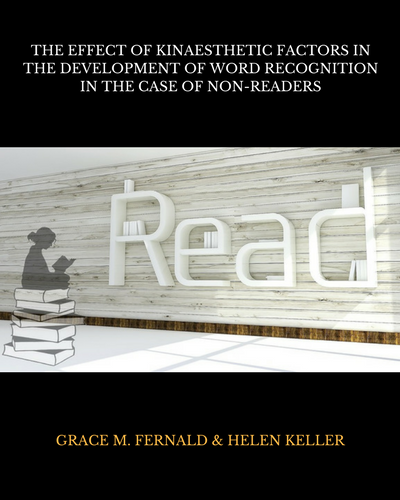
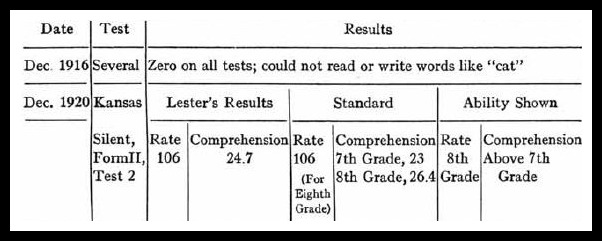

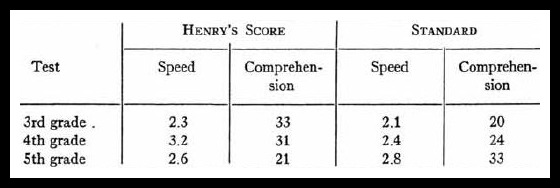
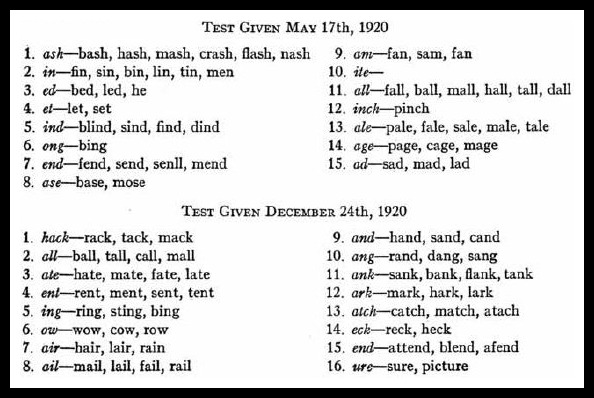
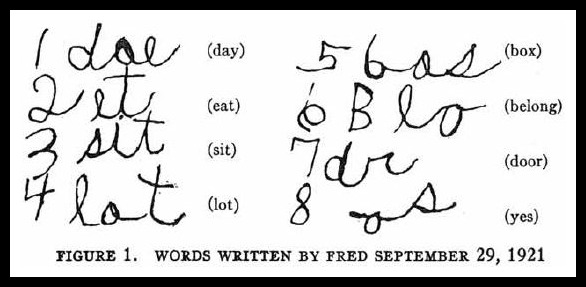
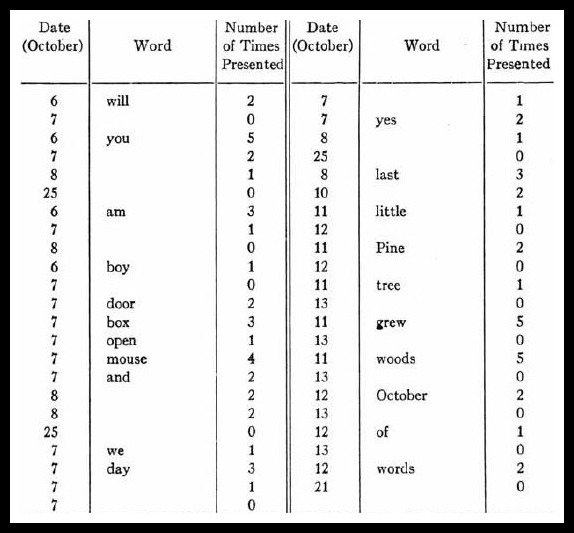
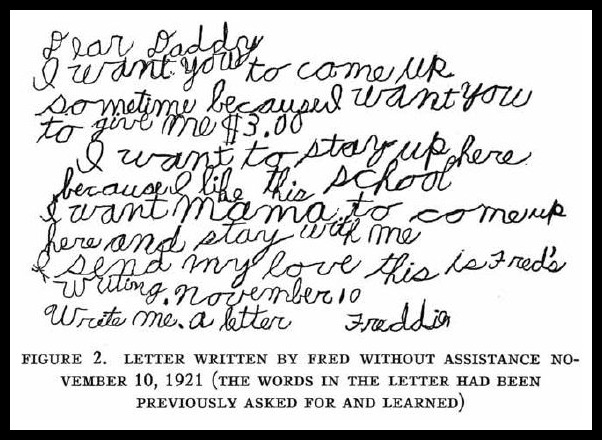
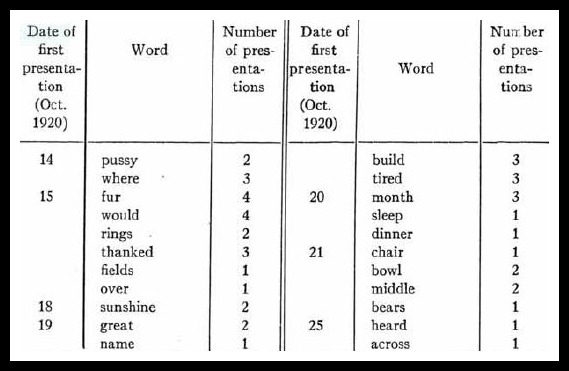
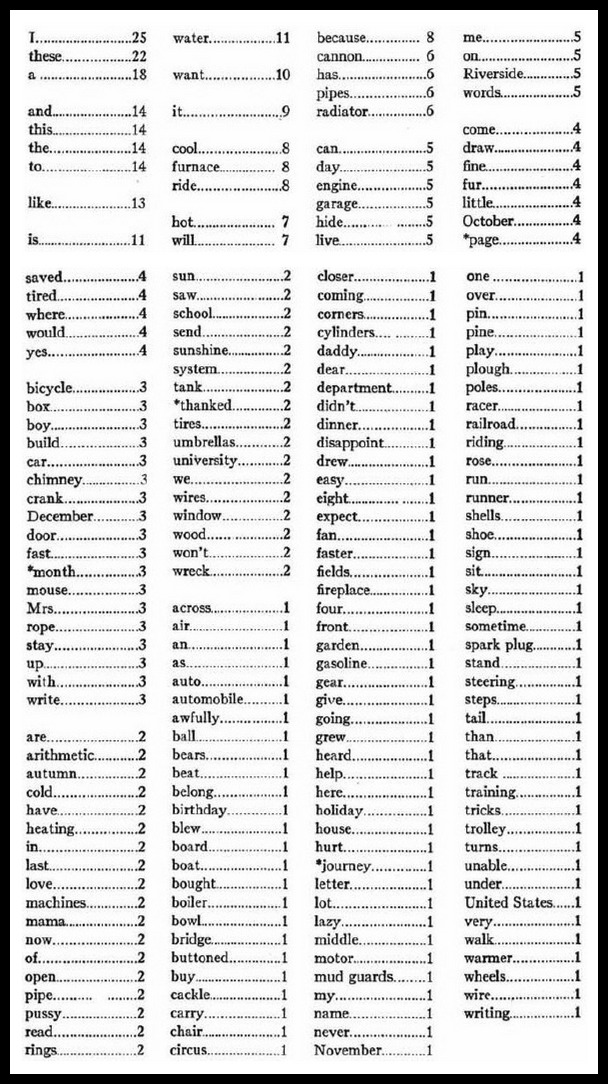
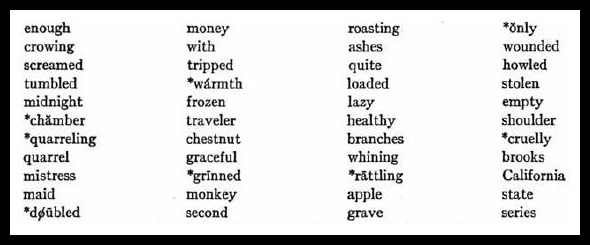

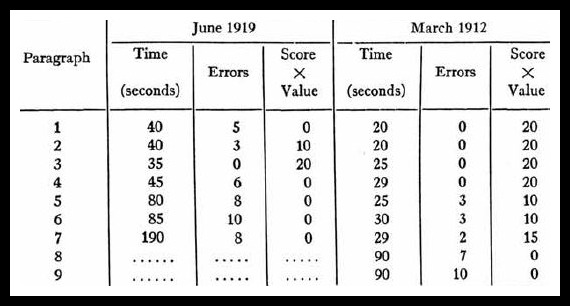



New! Comments
Have your say about what you just read! Leave me a comment in the box below.